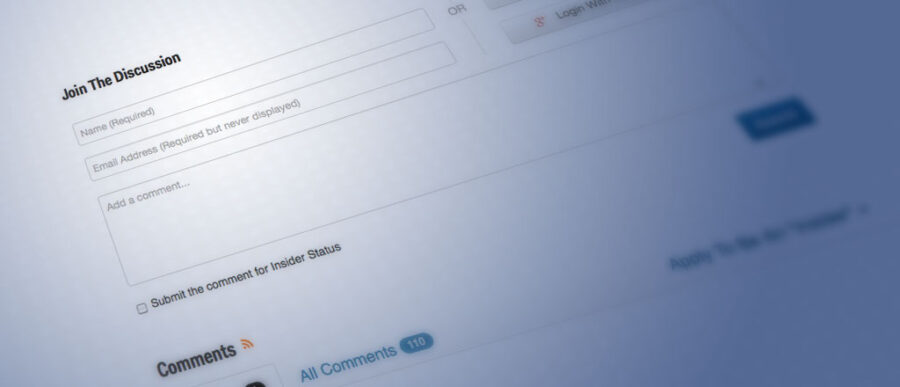It is a familiar sight for any self-proclaimed news junkie: Scroll beyond the end of a story on a newspaper’s website, and there likely is a tumultuous assortment of comments from readers. If the topic is political — and, quite often, even if it is not — the conversation devolves into a partisan spat. Depending on the publication, these spirited contributions will tend to appeal either to conservatives or to liberals.
A story about health care reform on the The Wall Street Journal’s website, for example, might lead a reader to comment: “Health insurance works like Marxism.” A story on The New York Times’ site about the same topic might yield an entirely different response: “The best way to get Medicare under control is to stop the fraud and put everyone under a national health care system which allows ZERO profits.”
Both statements actually appeared in the comments sections of those newspapers, and they were not unique in their tones — the Journal broadly is considered appealing to the political right; the Times, to the left. The comments were among samples appended to a paper titled, “User-Generated Content and Bias in News Media,” co-authored by Wharton marketing professor Pinar Yildirim and University of Pittsburgh economists Esther Gal-Or and Tansev Geylani.
Several years ago, Yildirim noticed while watching CNN and other news networks that contributions from social media were increasingly offered alongside reports. Twitter-fueled comments would appear on the crawl at the bottom of the screen. She found herself thinking, “Why do I care about the opinions of [random strangers] as opposed to [those of] the news editor? Why is it that [news outlets] might be doing this integration? It’s a risk to journalists’ jobs.”
She also wondered whether including such user-generated content helped or harmed the profession and the industry. “If they are doing this,” she says, “they [need to be careful] about what kind of content they integrate — which tweets, for example, they might pick to broadcast.”
Around the same time, Yildirim happened upon a 2007 Accenture survey of more than 100 senior executives in the media and entertainment industry. Fifty-seven percent of the survey’s respondents identified the rapid growth of user-generated content as one of the top three challenges they faced. Yildirim saw a subject worthy of investigation.
Confirming Bias
Yildirim and her co-authors were aware of a significant correlation between individuals’ political beliefs and the cable news stations or newspapers they choose. They predicted that the inclination to add user-generated content to news media would correlate with the polarization of ideology. According to the researchers, the more extreme a person’s political views, the more active he or she likely would be in generating content, compared with users whose political opinions were moderate. (Yildirim and her colleagues based that assumption on a stream of psychological research that has shown that people with more extreme views tend to more actively express those views.)
They began with two presumptions based on established research: First, that all consumers have an inherent need to see the facts. At the same time, however, consumers prefer news media that are aligned with their own political opinions. “[People] are more likely to enjoy [consuming] news that confirms their beliefs and values about the world as opposed to news that questions them,” Yildirim notes. This dichotomy reflects a conflict within the news consumer: He or she may want information that is bias-free, but he or she also may enjoy information that is biased, even when that bias is understood.
Specifically, the researchers’ paper addresses “the question of how introducing an online edition to supplement a print edition is likely to affect the extent of slant in reporting the news and the profits of newspapers.” For the purposes of their study, Yildirim and her colleagues assumed that only the online version could incorporate readers’ input. To explore the impact on profits, they considered both subscription and advertising fees as revenue sources and the fact that offering a print version is more costly than offering an online edition.
The addition of an online edition to a newspaper leads to a reduction of bias in its print edition, the researchers found.
In their theoretical model, consumers in a two-newspaper market would first choose a newspaper based on the political position of the publication and then choose either the online or print version based on their desire for an opportunity to post their political views.
“When a newspaper decides to add an online variant to supplement its print version, it expands its product mix to consist of two products with differing levels of bias in reporting,” Yildirim and her co-authors note. That bias is higher online, they contend, because of the content supplied by subscribers: “[When user-generated content] is added by readers to the online editions, each newspaper is indirectly forced by subscribers to offer two differentiated versions of its product,” they write.
Ultimately, profitability of the newspaper “declines in comparison to an environment where a newspaper chooses the political position of both of its editions.” The addition of an online edition to a newspaper, the researchers note, leads to a reduction of bias in its print edition. That fosters competition for print subscribers, resulting in lower fees. Meanwhile, online subscribers actively determine the extent of the slant in an online edition, sapping from the newspaper some control over the attributes of its online product. That, too, means reduced profitability.
Nonetheless, each paper must offer an online version so as to maintain market share, Yildirim and her co-authors point out. They found that the addition by one newspaper of an online edition that includes user-generated content essentially forces a print-only competitor to follow suit: “[W]hen Newspaper 1 limits its product mix in comparison to Newspaper 2, it loses market share, and Newspaper 2 attracts more than 50% of the readers to one of its two editions,” Yildirim says.
Segmenting the Market
The vitriol that can stem from user-generated content, meanwhile, might actually be a boon to news media managers. “I think [publications] are being somewhat smart about this. They are strategically using the difference in opinions and the level of activism as a way to segment the market and, with the help of consumers, they are creating products that appeal to the opinions of a broader range of consumers.”
Expressions of extreme views, she adds, may alleviate the pressure journalists might feel to write stories in a slanted fashion — like-minded readers, in other words, are fulfilling each other’s desire to be heard. Her research has found that this helps reduce news media bias in the industry as a whole.
“The content users generate can change perceptions about a newspaper’s general political affiliation or position in the marketplace, and that has an impact on [an individual’s] desire to consume a news product.”
“[This kind of vitriol] sounds bad at first,” Yildirim notes, “but if you look at it more carefully, the results might be positive with respect to the amount of bias in the news industry.”
Her research found that profits, however, likely will suffer. If the Times’ and the Journal’s print editions each edged toward the political center, their increasing similarities would foster fiercer price competition for subscribers. “If they are providing [too] similar content, consumers may be inclined choose a newspaper that makes them spend less,” Yildirim says. “Lower differentiation in the media may hurt profits.”
She is careful, though, to note that the news media industry’s financial woes are due to several factors, of which user-generated content is but one. And the model “predicts that profits decline even when newspapers charge for access to their online editions.”
Managers, meanwhile, could benefit from knowing that their online versions, largely due to user-generated content, might be attracting a different crowd than their print versions, Yildirim notes. Editors and producers might become more inclined to develop different content for online and print products. But even if the journalistic process remains the same, she adds, “as the manager, I should know that the content users generate can change the perceptions about the newspaper’s general political affiliation or position in the marketplace, and that has an impact on [an individual’s] desire to consume a news product. This may have significant profit implications.
“Decline in profits due to added user content is unfortunately not the best outcome for the news media,” she continues. “But because the competitive pressure to include user content will continue to exist in the marketplace, I don’t expect a move [away from user-generated content].”



